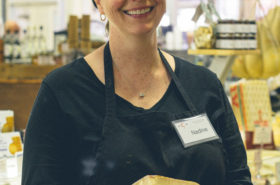At Carlino’s, we have cheeses with one milk, two milks, or even three milks, and other cheeses that are double or triple cream. Another possibility is cheese with milk from one animal and cream from another. OK, let’s stop calculating the options (which all sound yummy and are making me hungry) to talk a bit about what the differences are and what they mean for the final products.
As I discussed in a previous article, cheese is made with milk, usually from cows, sheep, goats, or a combination of them and determines certain characteristics of the cheese. For more information, check out my article titled “Cheese 101.” Here we’ll focus on double and triple creams.
Contrary to what the names suggest, double and triple creams are not made with two or three different kinds of cream. They are both made by adding cream before the curd is formed. (We’ll save the science behind cheese formation for another day.) The difference is how much cream is added and the resulting level of butterfat in the cheese. Double creams finish with 60-75% butterfat, while triple creams must consist of over 75% butterfat. As a comparison, butter must be at least 80% fat.
Those numbers might sound a bit high, but in cheese, it’s the percentage of butterfat in the dry matter – what would remain if all the moisture had been removed. Luckily, at least for my heart, both versions are fairly young and contain high levels of moisture. As cheeses age, they lose moisture but the dry matter stays consistent, leaving a denser final product; a one-inch block of Parmigiano-Reggiano will weigh more than a one-inch piece of Brie.
The first double cream was Petit Suisse and was made in Normandy in 1850, with the first triple cream also being made in Normandy but not until 75 years later. It was created by the Dubuc family, was called Le Magnum and laid the foundation for Brillat-Savarin. Sound familiar to anyone? It’s a cheese we usually have available at Carlino’s, including quite a few other double and triple creams.
So now that we know the history and the makeup of these cheeses, what do they actually taste like? After all, learning about cheese is one thing, but eating them is much more fun! If you’ve been in the store looking for something softer to add to your cheese platter, you’ve probably heard me refer to “cheese butter.” Based on what we learned above, not too surprising, right? Some tend to be milder, while others a bit more tangy or have a salty sharpness. We even have a triple cream blue (one of my favorites) or the Champignon, a triple cream with mushrooms.
Because of the richness of the double and triple creams, they tend to pair well with bubbly beverages, like champagne, and are delicious with fresh fruit. And yes, the rinds are edible. It’s a lovely protective layer allowing the cheese to ripen from the outside in and is covered in cultures of yeast and mold (basically penicillin). If you’ve never tried the rind before, give it a go. You may find it’s not for you, but you won’t know until you try.
So whenever you’re ready for a hands-on lesson in double and triple creams, stop by the cheese counter at Carlino’s and let us show you the wonderfully delicious options available in this family of cheeses.





